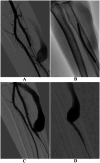Endovascular Treatment of Malfunctioning Dialysis Fistulas: A Multicenter Retrospective Analysis Comparing Transradial and Conventional Transvenous Access
- PMID: 39723562
- PMCID: PMC12231155
- DOI: 10.1002/ccd.31349
Endovascular Treatment of Malfunctioning Dialysis Fistulas: A Multicenter Retrospective Analysis Comparing Transradial and Conventional Transvenous Access
Abstract
Background: Venous outflow is the favored access for endovascular management of dialysis fistulas. However, transradial access (TRA) offers advantages in specific clinical scenarios. The study aims to compare the efficacy, feasibility, and safety of TRA and transvenous access (TVA) in the endovascular management of malfunctioning dialysis fistulas, addressing the existing gap in comprehensive literature.
Methods: A retrospective multi-center analysis included prospectively collected data (January 2021-November 2023) from patients undergoing endovascular management of malfunctioning dialysis fistulas with TRA. Control groups comprised patients with TVA.
Results: Of 206 patients, 62 underwent TRA, and 144 underwent TVA. Baseline demographics showed a well-matched distribution. TRA exhibited longer cannulation times but similar procedural and fluoroscopy times. Technical success rates were high for both TRA (98.4%) and TVA (97.2%). Clinical success rates were comparable (96.8% vs. 95.8%). Postprocedure access flow rates and complications demonstrated no significant differences.
Conclusions: This study provides the first direct comparison of TRA and TVA in malfunctioning dialytic fistulas. While venous outflow remains the standard vascular access site for managing malfunctioning dialysis fistulas, TRA shows comparable efficacy, safety, and feasibility, making it a viable alternative in specific clinical contexts. Further studies are needed to confirm these findings and to determine the long-term durability of TRA.
Keywords: endovascular management; hemodialysis fistula; malfunctioning dialysis fistulas; radial artery; transradial access; transvenous access.
© 2025 The Author(s). Catheterization and Cardiovascular Interventions published by Wiley Periodicals LLC.
Conflict of interest statement
The authors declare no conflicts of interest.
Figures

Similar articles
-
The Alpha to Omega of Dialysis Access: Arteriovenous Fistula and Graft (Part 1).Vasc Endovascular Surg. 2025 Jul;59(5):513-527. doi: 10.1177/15385744251328396. Epub 2025 Mar 24. Vasc Endovascular Surg. 2025. PMID: 40123557
-
The trans-radial approach for endovascular intervention of the problem arterio-venous fistula: A single-centre case series and systematic review.J Vasc Access. 2025 Sep;26(5):1681-1692. doi: 10.1177/11297298241299904. Epub 2024 Nov 24. J Vasc Access. 2025. PMID: 39582185
-
Long-term outcomes of radiocephalic arteriovenous fistulas created in anatomical snuffbox or with VasQ external support device.J Vasc Surg. 2025 Jul;82(1):229-239. doi: 10.1016/j.jvs.2025.03.166. Epub 2025 Jun 4. J Vasc Surg. 2025. PMID: 40464722
-
Interventions for thrombosed haemodialysis arteriovenous fistulas and grafts.Cochrane Database Syst Rev. 2024 Feb 14;2(2):CD013293. doi: 10.1002/14651858.CD013293.pub2. Cochrane Database Syst Rev. 2024. PMID: 38353936 Free PMC article.
-
Ultrasound guided percutaneous sharp recanalization for restoring patency from peripheral chronic total occlusions of hemodialysis accesses.J Vasc Access. 2025 Jul;26(4):1294-1302. doi: 10.1177/11297298241273610. Epub 2024 Aug 24. J Vasc Access. 2025. PMID: 39180347
References
Publication types
MeSH terms
Grants and funding
LinkOut - more resources
Full Text Sources
Medical
Miscellaneous

